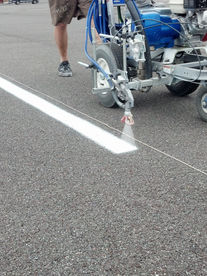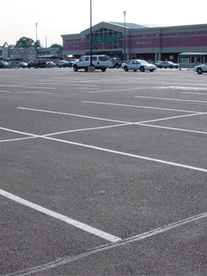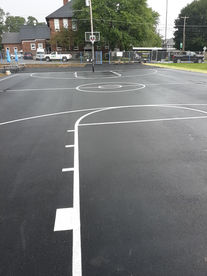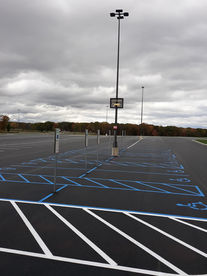
Parking Lot Layout Striping
Parking Lot Striping Services in the Poconos and Lehigh Valley PA
Our Parking Lot Stripers Have the Equipment & Experience Necessary to Ensure That Your Parking Lot is Safe, Welcoming, & Up-to-Code
Create a Layout for Your Parking Lot That Makes Sense
Proper parking lot striping is essential for creating an organized, safe, and efficient environment for both drivers and pedestrians. A well-striped parking lot improves traffic flow, maximizes available space, and ensures compliance with accessibility and safety standards. Clear markings help direct vehicles and pedestrians, reducing confusion and the likelihood of accidents. Whether designing a new parking lot or re-striping an existing one, careful attention to detail is crucial for achieving optimal results that meet both functional and aesthetic goals.

Key Considerations When Designing a Layout
1. Layout Design
A functional parking lot layout is the foundation for effective striping. The design should accommodate vehicle sizes, parking angles, traffic directions, and designated zones for specific purposes such as loading areas, reserved parking, or bike racks. For instance, compact parking spaces may be included in areas with high car turnover to save space, while larger spaces should be allocated for trucks or oversized vehicles. Lane widths, turning radii, and driveway access points should be carefully planned to allow for smooth navigation throughout the space. A thoughtful layout not only improves functionality but also provides a positive first impression for visitors.
2. Compliance with Regulations
Parking lots must adhere to local building codes and the Americans with Disabilities Act (ADA) requirements. Compliance includes providing accessible parking spaces with proper dimensions, clear signage, and safe pathways that connect parking areas to entry points. These accessible features enhance usability for individuals with disabilities, ensuring equal access for everyone. Additionally, some regions require specific markings for fire lanes, loading zones, or no-parking areas. Ignoring these regulations can result in fines, legal action, or reduced usability of the parking lot. Consulting regulatory guidelines during the design phase ensures the parking lot is both functional and legally compliant.
3. Safety and Visibility
Safety is a top priority in parking lot striping. Striping paint should be durable, highly visible, and weather-resistant to withstand heavy foot and vehicle traffic, as well as environmental factors like rain, snow, and UV exposure. Clear markings, such as directional arrows, stop bars, pedestrian crosswalks, and no-parking zones, play a critical role in guiding users and minimizing the risk of accidents. For added visibility, reflective paint and vibrant colors can be used to enhance markings, particularly in areas with low lighting. Safety considerations extend to proper signage placement, ensuring that drivers and pedestrians can easily understand traffic flow and designated areas.
4. Maximizing Space Efficiency
Effective striping can optimize space usage, increasing the number of available parking spots without compromising safety or accessibility standards. Angled parking may work well for smaller lots, as it allows for easier entry and exit, while parallel or perpendicular spaces may be better suited for larger lots. Multi-zone designs can accommodate different types of traffic, such as separate areas for short-term parking, employee parking, or delivery vehicles. By planning carefully, you can make the most of the available space while maintaining a safe and organized layout that meets the needs of all users.
5. Regular Maintenance
Routine inspections and maintenance of striping are necessary to keep markings vibrant, visible, and functional over time. Faded, damaged, or worn markings can lead to confusion, improper parking, and increased safety risks. Re-striping should be performed promptly when visibility declines to maintain clarity and compliance with local codes. Additionally, parking lot surfaces should be inspected for cracks, potholes, or debris that could impact striping effectiveness. Periodic updates to markings also ensure the layout remains consistent with evolving traffic patterns, regulations, and user needs.
Types of Parking Lot Layouts
Choosing the right parking lot layout is essential to maximizing the functionality, efficiency, and safety of your space. There are several common parking lot layouts, each designed to suit different needs and environments. Here are some of the most widely used layouts:
1. Perpendicular (90-Degree) Parking
This is one of the most frequently used designs and features spaces arranged at a 90-degree angle to the driving lanes. It allows for high parking density and is ideal for most commercial areas, though it may require more space for vehicles to maneuver into and out of spots.
2. Angled Parking
Angled parking spaces are typically set at an angle ranging between 45 and 60 degrees. This layout promotes smoother traffic flow, reduces the risk of accidents, and facilitates easier parking. However, it requires more surface area compared to perpendicular layouts.
3. Parallel Parking
Commonly found in urban areas, this layout involves vehicles parked parallel to the driving lane. While it optimizes the use of narrow spaces, it may be more challenging for drivers to park and limits the overall number of spots.
4. One-Way and Two-Way Layouts
Parking lots can also be categorized by traffic flow. One-way layouts, with angled spaces, are efficient for guiding traffic in a single direction, whereas two-way layouts accommodate two lanes of traffic and often use perpendicular parking spaces for convenience.
Each layout offers unique advantages, and selecting the right one depends on factors such as available space, user traffic, and the nature of the property. Consulting with experienced professionals can help ensure your parking lot layout meets local regulations and optimizes functionality for all users.
Benefits of Professional Line Striping Services
Relying on a trusted professional striping service can save time, ensure compliance, and enhance the overall performance of your parking lot. Professional contractors have the expertise, equipment, and materials needed to deliver clean, precise, and durable results efficiently. They also stay updated on the latest code requirements, guaranteeing that your parking lot meets legal and accessibility standards. Beyond technical expertise, professional striping enhances the visual appeal of your lot, helping to create a welcoming environment for visitors, employees, or customers.
Investing in quality parking lot striping not only improves the functionality and safety of your parking area but also conveys a strong message about your commitment to organization and attention to detail. A properly striped parking lot shows that you value the safety, convenience, and experience of every person who uses your space. With proper planning, regular maintenance, and professional assistance, your parking lot can remain a valuable asset for years to come, supporting your property’s overall success and usability.














